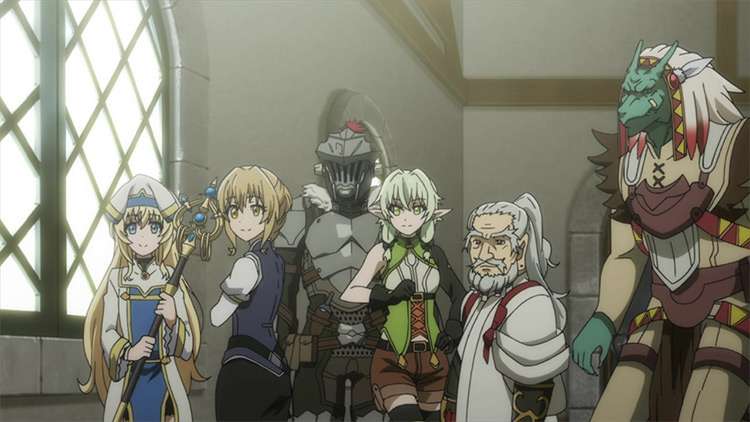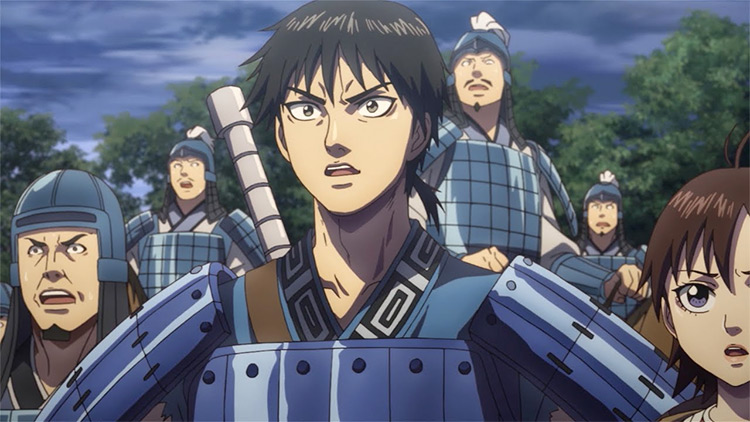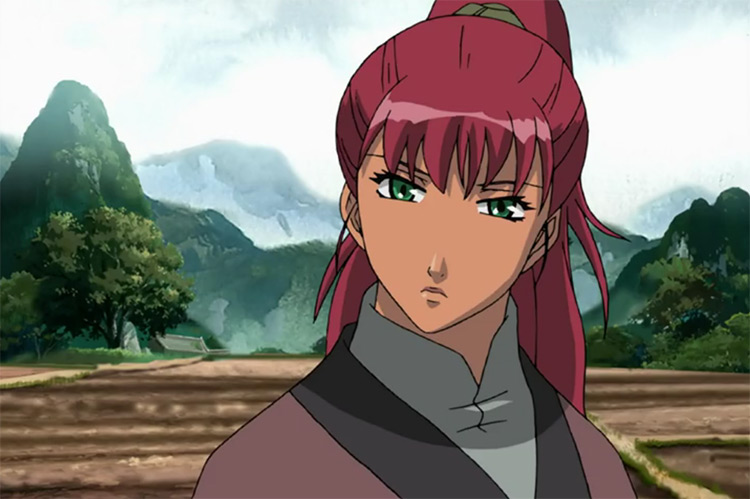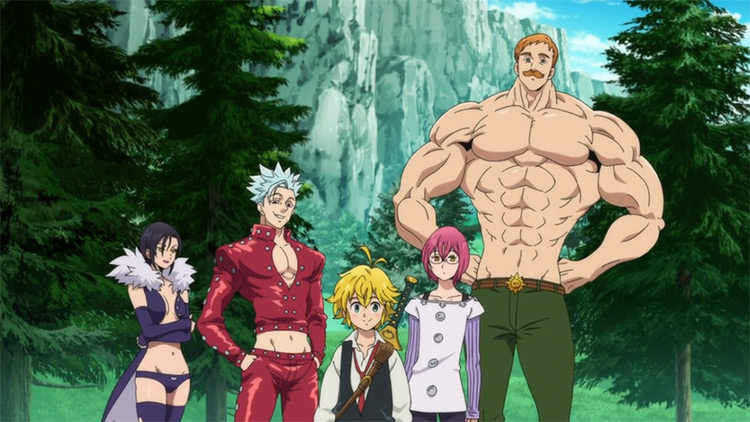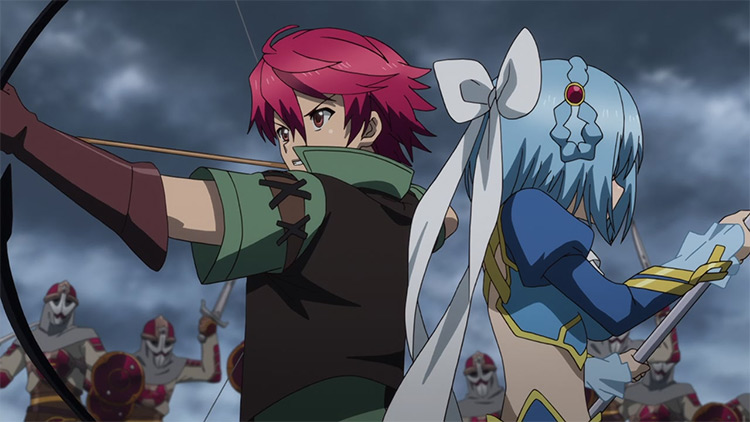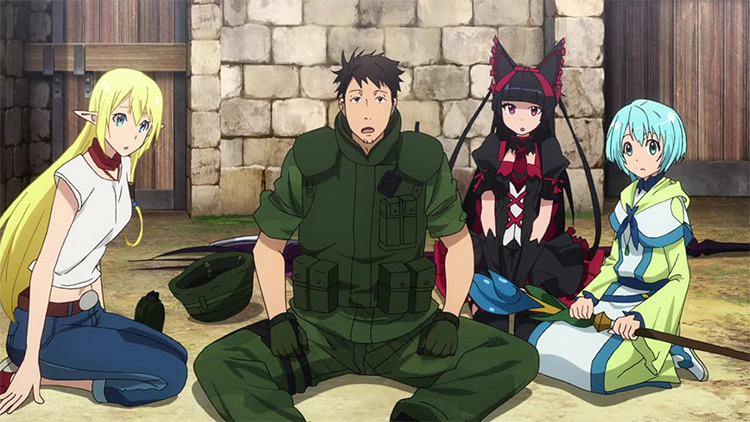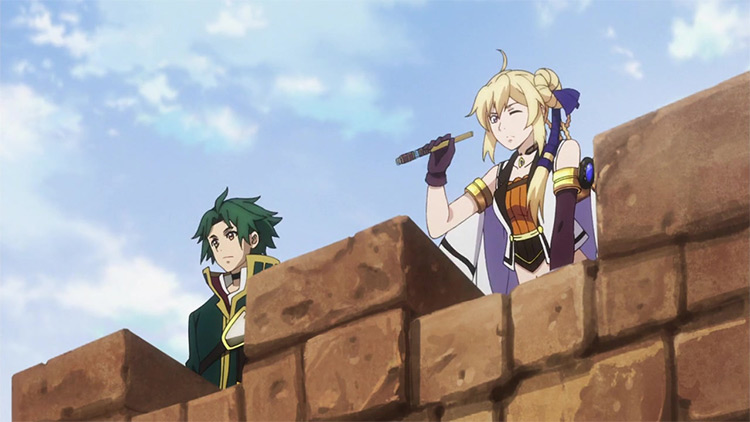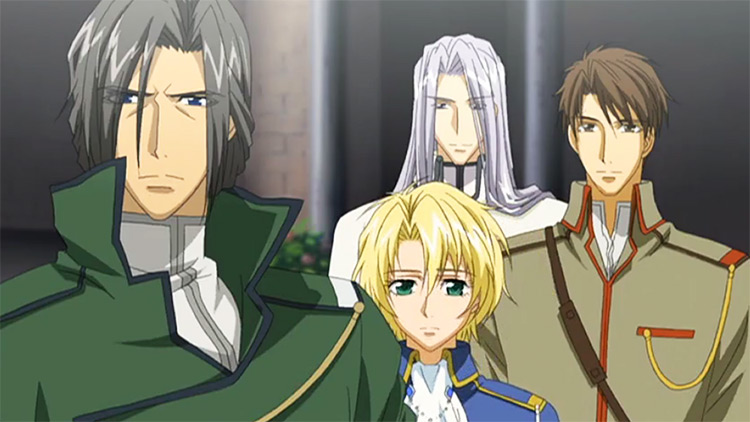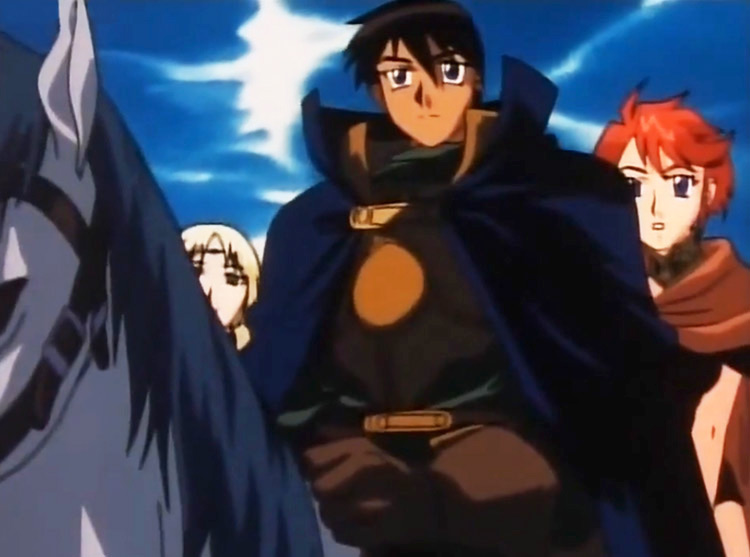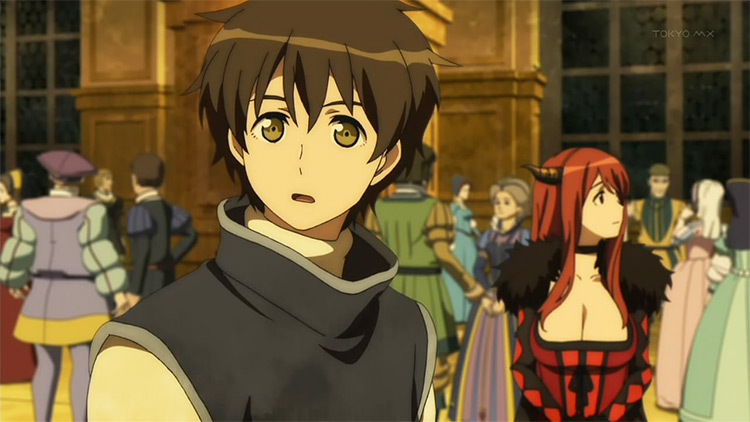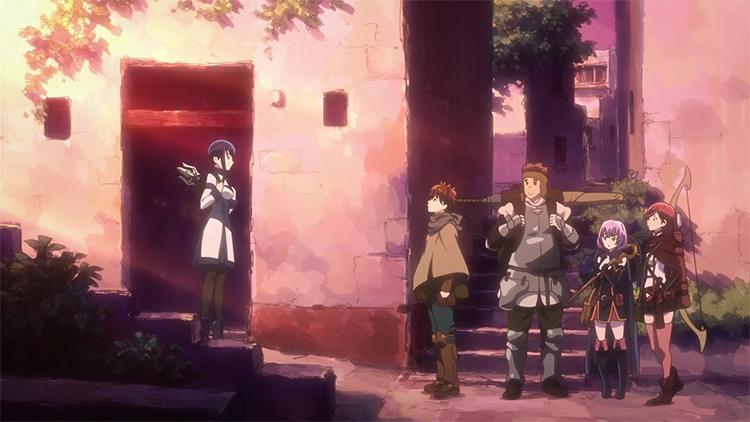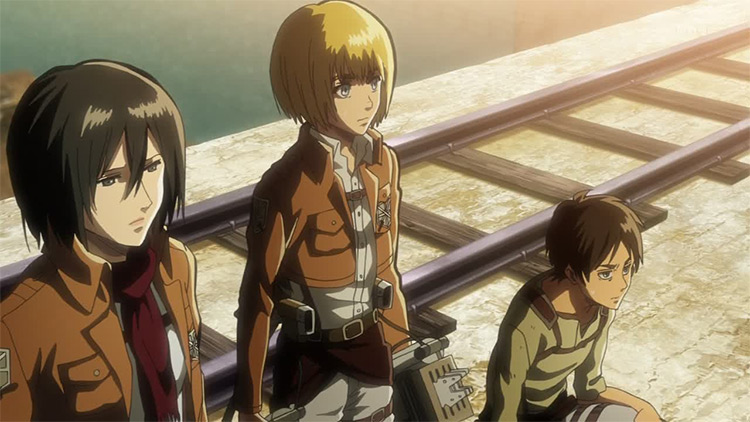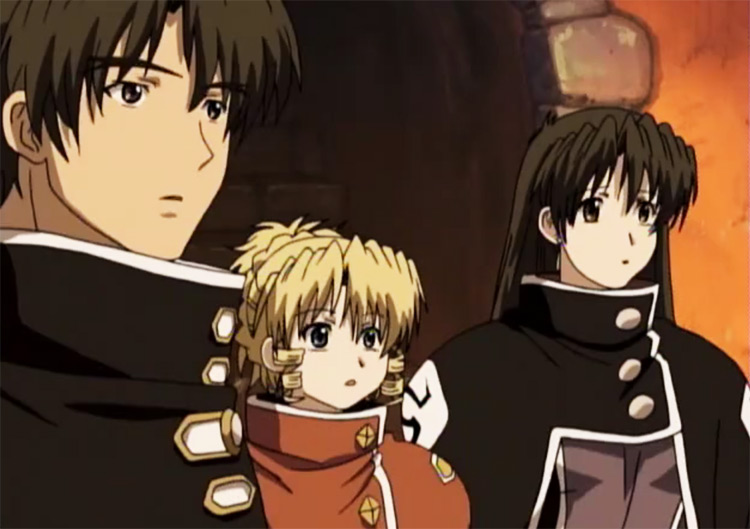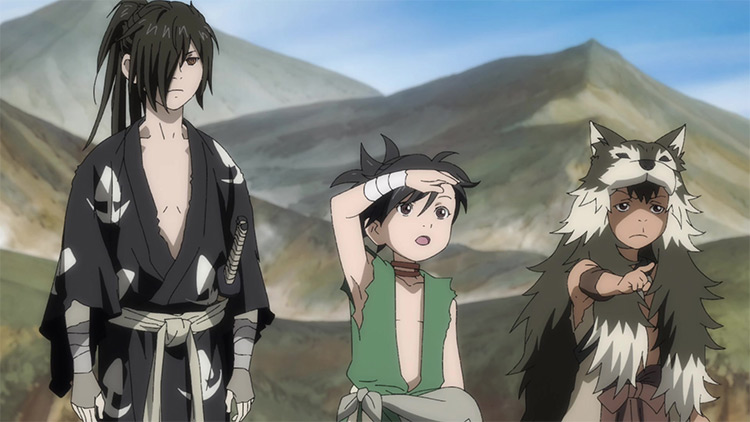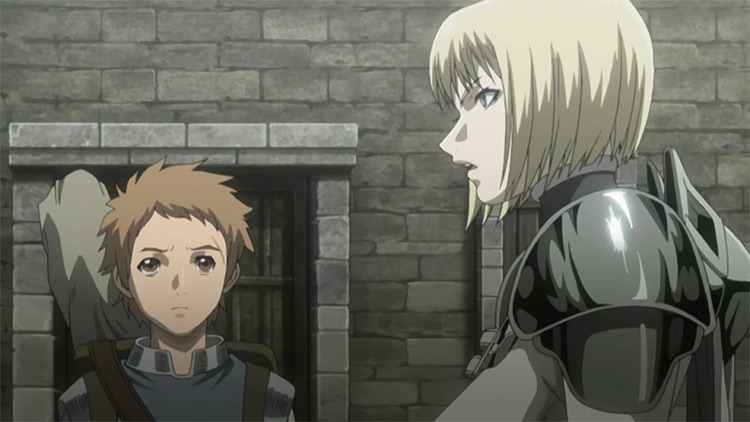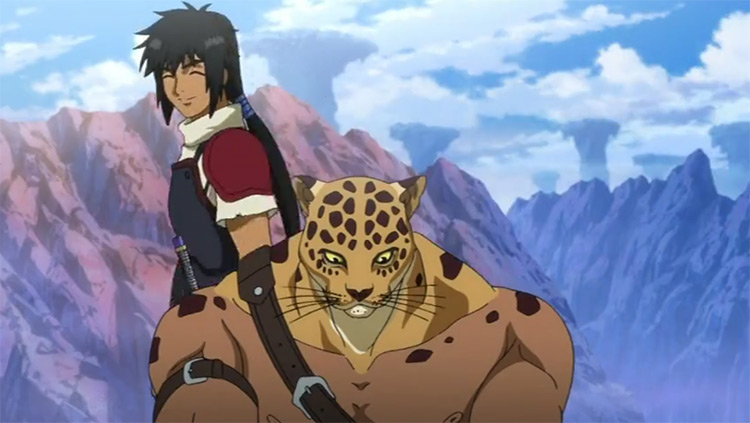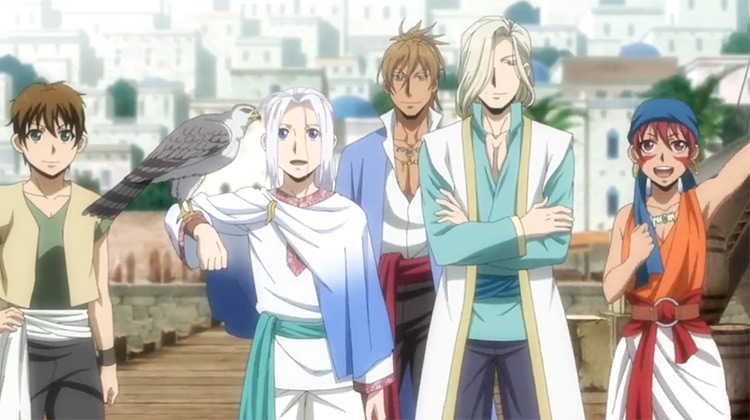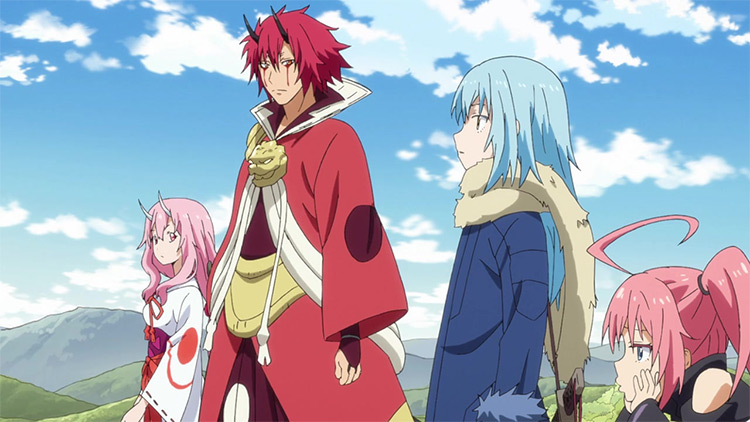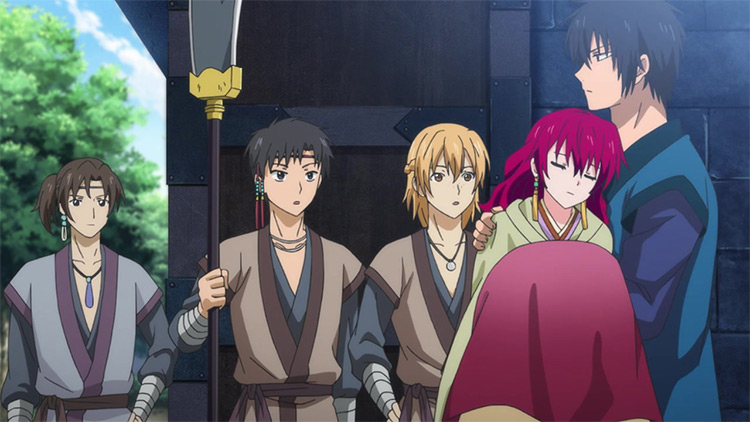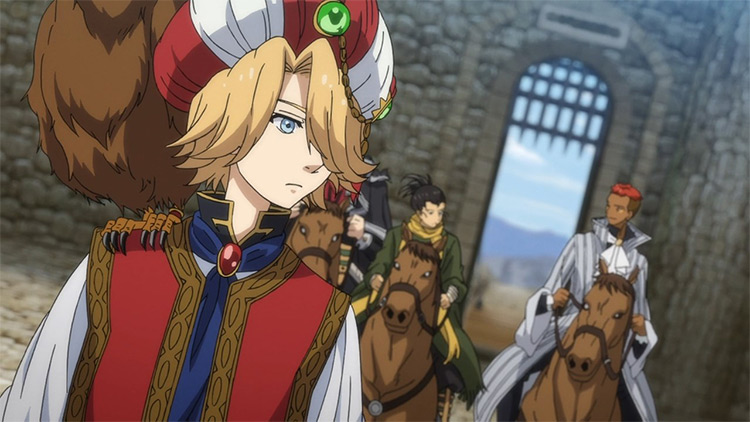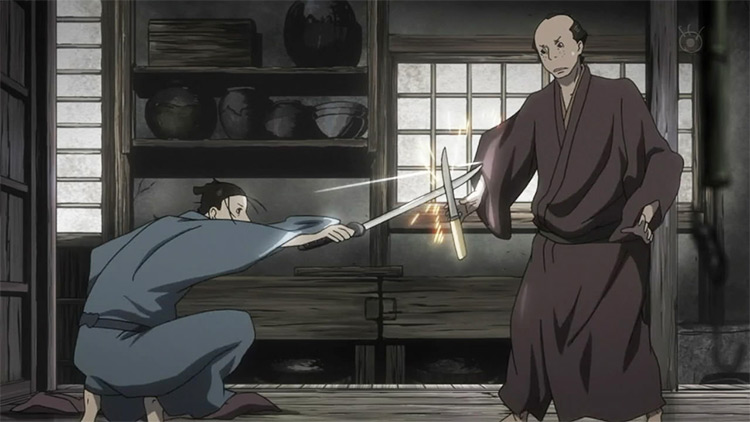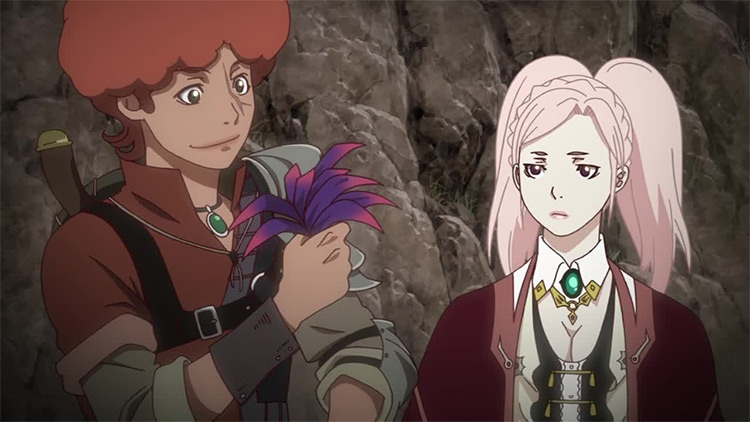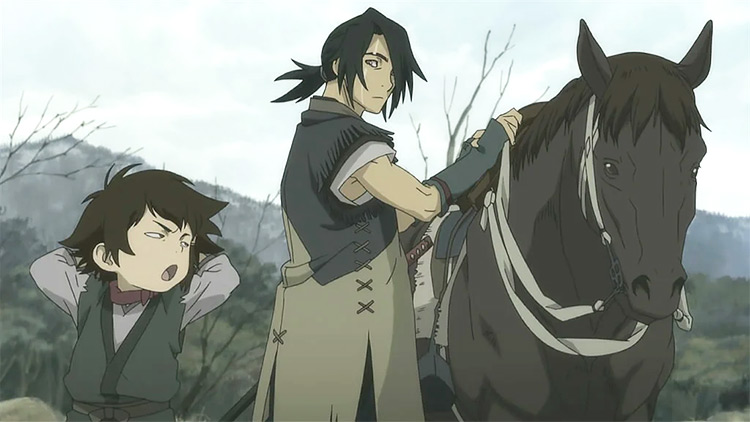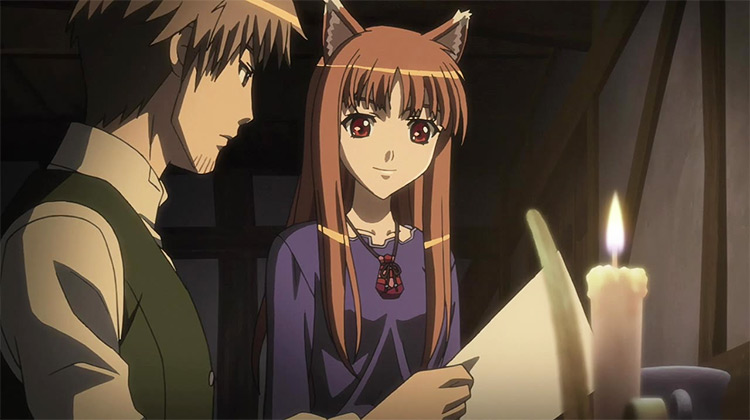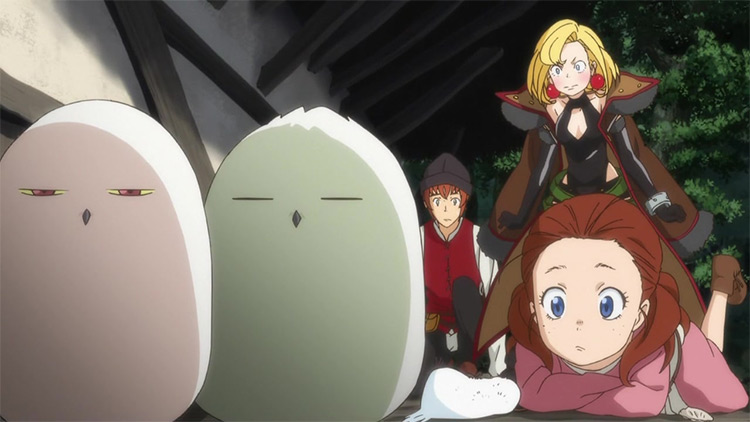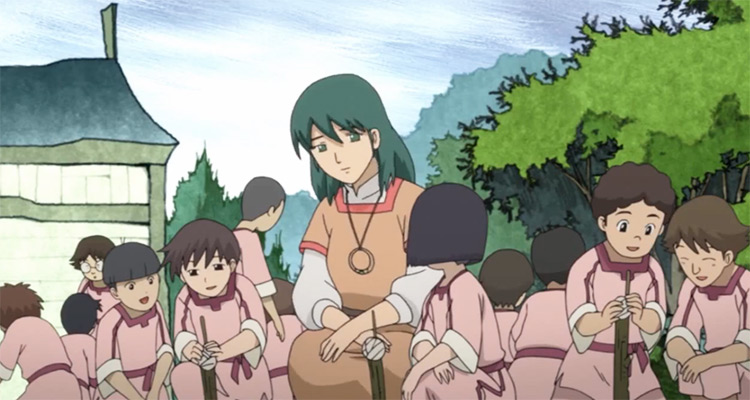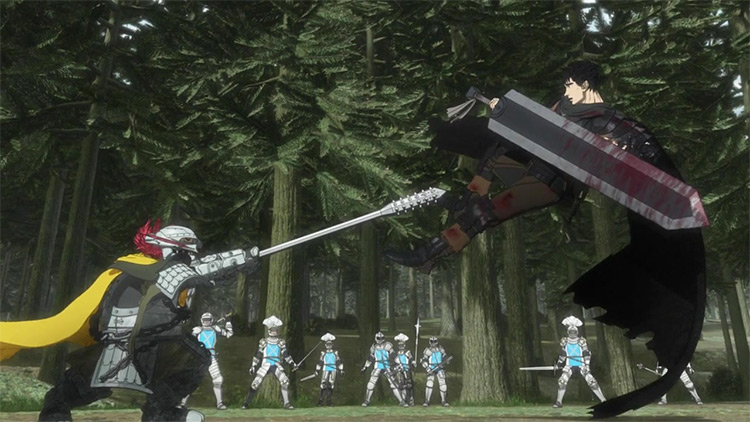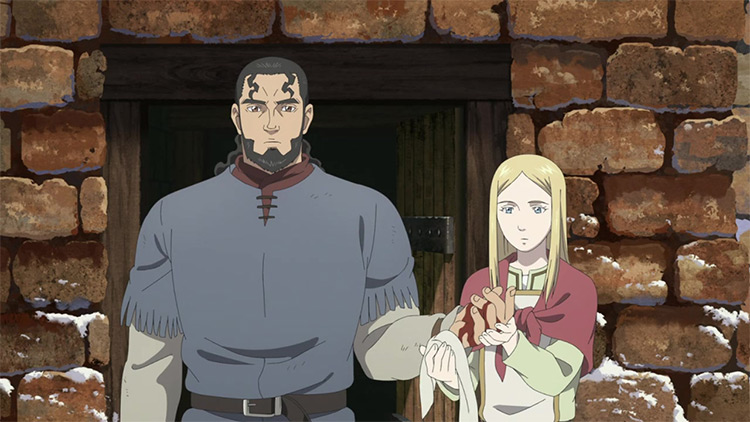And since we’re talking animation, there’s some weird plots set in the Medieval Period — not to mention shows that do contain Medieval elements, but ultimately have their own unique worlds in different time periods. If you’re in the mood for knights and kings (and perhaps bloody warfare) check out my picks for the best medieval anime worth checking out. Warning: Possible spoilers below.
30. Goblin Slayer
The inclusion of Goblin Slayer tells you that I’m including fantasy and isekai-esque anime series, but only if I feel they have medieval elements. As one of the most popular (and controversial) series of 2018, Goblin Slayer features the unnamed, well… goblin slayer at the forefront. Like a mere pawn of a nation at war, he prefers to wear leather armor with a typical chain mail — and he has a helmet protecting and concealing his face. Goblin Slayer looks good (thank you, White Fox) and offers a unique premise, showing goblins not as weak and laughable creatures, but as ruthlessly evil monsters with a penchant for violating women. The Middle Ages were indeed a terrible period for women (and humans in general). But I can’t say that Goblin Slayer maximized its potential for peeling the layers of sexual violence. It didn’t have to, I know, but it would’ve made it more memorable instead of just being an alright dark fantasy series.
29. Kingdom
Surprisingly, the third season of Kingdom started in early 2020 — and fans of the anime adaptation and the manga seemingly love it more than the first two seasons. But as it is, Kingdom is a historical epic (with fictional changes, of course) based on the Qin Dynasty and Ancient China in general. It gets its spot here for its medieval-esque aspects: wars using melee weapons and heavy armor, constant political tension, and the hardships of living in such a chaotic time. Also, Kingdom isn’t afraid to get a little brutal when it wants to, given the source material.
28. Juuni Kokuki (The Twelve Kingdoms)
Kingdom may have three seasons that improve one after the other, but The Twelve Kingdoms needed just 45 episodes to leave a positive mark. This anime is inspired by Chinese mythology. As its title implies, the fantasy world the MC (and her two classmates) suddenly find themselves in has twelve kingdoms and feature war and famine, two things you probably associate the most with the Middle Ages. I thought this was going to be pretty average as a fantasy series, but I actually like how it dug fairly deep into the social, economic, political, and even philosophical elements — and the development of the MC is fantastic.
27. Nanatsu no Taizai (The Seven Deadly Sins)
I’m not a huge fan of The Seven Deadly Sins as an anime. That’s not to say that it’s outright terrible… it’s just that I’m not part of its primary target audience. However, I can still appreciate and acknowledge its strengths. Those include character design, settings, and select action sequences — even the ecchi parts are okay. The fantasy world is pretty much the Middle Ages, except with monsters, magic, and characters with interesting (or should I say unbelievable) proportions. And with over 70 episodes since its premiere in 2014, Nanatsu no Taizai has a ton of content to please new and old viewers alike.
26. Lord Marksman and Vanadis
Lord Marksman and Vanadis is certainly a medieval anime… at least in the sense that it’s a blend of old Europe and fantasy elements. Its world has archers, warriors, earls, and countries in conflict. Plus I think the visuals of huge banners and massive armies in heavy armor were well-executed. Yet the pacing and overall story were far from great, and the main characters weren’t as memorable. I wish the 3D animation was better, since the employment of military strategies was commendable. But Lord Marksman and Vanadis does well enough (as an ecchi harem series, if I may add) to get this spot.
25. Gate: Jieitai Kanochi nite, Kaku Tatakaeri (GATE)
At this point, you’ve probably guessed that a good number of my favorite medieval anime are fantasy shows. Which isn’t surprising — it’s easier to attract viewers to your show if your “boring”, realistic anime gets a magical enhancement (and kawaii magical girls are often part of this). I like the idea behind GATE. It mixes modern military action with medieval, fantasy warfare. It’s a literal clash of worlds, and I love that viewers witness the stark contrast between feudal and modern societies. And it’s not just about the weapons and setting. Some of the norms in the fantasy medieval world won’t be welcomed with open arms by today’s Japanese citizens, especially those about women and prisoners. Still, as much as GATE spent time exploring the socio-cultural and political differences, this is a show with a male otaku in his 30s who gets to build his harem of medieval fantasy women. What’s not to love?
24. Grancrest Senki (Record of Grancrest War)
If Grancrest Senki looks much better than most entries here, that’s because it’s a 2018 anime from A-1 complete with licensing by Aniplex of America. Like many entries, its spot here is earned by its use of medieval warfare (of course, with magic) and political intrigue. The visuals, from the landscapes to the castles, are commendable — and the score complements the intense fight scenes well. However, the pacing isn’t the best. And you’ll probably need a rewatch to better understand what’s going on. If that’s not an option for you, head straight for the source material.
23. Kyou kara Maou! (King From Now On!)
Back in 2004, Studio Deen released King From Now On, which was neither impeccable in its visuals or story, but it’s one of the more memorable medieval series I’ve seen. It’s silly that the MC got transported to a world like Medieval Europe because bullies at school made him put his head into a toilet… but it’s been enjoyable. Including the OVA, you get a total of 122 episodes — and I’m sure you’ll find the world of noble families entertaining, especially when Wolfram von Bielefeld enters the spotlight. Soon enough, you’ll realize why he became one of the most beloved characters in the series.
22. Record of Lodoss War
Record of Lodoss War was released in 1991 as a 13-episode OVA. As such, it’s almost two decades old. But here’s the great thing: It’s a Madhouse production. And I sure love the art style of anime in the 1990s. The animation is far less lovable (and it didn’t age well), but it’s understandable. A 27-episodes series came out seven years later, this time by Studio AIC, but there’s no harm in trying just the OVAs. If you’re reminded of Dungeons & Dragons or Lord of the Rings, that’s fine: Record of Lodoss War redeems itself with gorgeous, symphonic music, and decent characters (including villains).
21. Maoyuu Maou Yuusha (Maoyu ~ Archenemy & Hero)
After the success of Spice and Wolf, the anime industry was looking for a possible new hit in the same vein. Something that would captivate people looking for an entertaining show with economic aspects. Interestingly enough, Maoyuu Maou Yuusha not only has the same director as Spice and Wolf (among other primary staff members), but it also had the same main voice actors. But don’t think this is a 1:1 copy. At its core, Maoyuu Maou Yuusha feels with larger economic dynamics, of how major shifts can drive national growth and improve government relations — all with the help of a guy (the hero) and a demon queen who just wants to achieve peace among demons and between humans and demons.
20. Hai to Gensou no Grimgar (Grimgar of Fantasy and Ash)
In a way, Grimgar of Fantasy and Ash is the opposite of Goblin Slayer. Both shows represented goblins in a more nuanced manner. But I absolutely believe Grimgar did a better job. Instead of doing a 180-degree turn and showing goblins as cunning violent creatures, this show focused on showing that it’s not a black-and-white issue. The goblins are living, breathing, thinking creatures. So when the teenagers hunt down their first goblin, Grimgar shows how the goblin feels as well — how it’s desperate and terrified of dying. Moreover, while Grimgar is an isekai show, its medieval aspects are more than about its weapons and armor choices: It understands the reality of physical weight and how killing isn’t a glorious thing. The characters struggle with handling their varied weapons (and pointing their magical skills), relative to how physically capable they are. Second, they don’t just brush aside the sight of blood and death as if it were a daily occurrence — these teens get to learn the ugly reality of violence real quick.
19. Shingeki no Kyojin (Attack on Titan)
Granted, the world of Shingeki no Kyojin is original in a lot of ways. But you can also notice its medieval elements — from its social stratification (Attack on Titan literally has huge walls dividing people by their perceived socioeconomic, political, and cultural value) to its war tactics, clothing, and reliance on horses. Similarly, as much as Shingeki no Kyojin is praised for its heart-stopping action sequences. It always has time for exploring its deeply religious and political themes, and how these two institutions often clash and shape the world. And while the real Middle Ages didn’t have man-eating titans, it was still as consistently terrifying and filled with oppression, lies, and inequality, as if there’s no point in hoping for a better world (and even the ending of Season 3 gave that impression).
18. Scrapped Princess
Before you scrap(get it?) this series, I implore you to at least go beyond the first half. The early episodes aren’t even boring. It’s indicative of your typical medieval fantasy anime, and Pacifica (and her brother and sister) are all fantastic. But while you can enjoy the well-animated action and the colorful landscapes (thanks, Studio Bones), you’ll likely be gripped by the development in the second half. Because as Scrapped Princess goes on, it becomes this unique show that goes further than its magical, medieval-style beginnings. Needless to say, the twists and turns (and the effective drama) more than compensate for the low amount of action.
17. Dororo (2019)
Feudal Japan is a relatively popular historical setting. Especially because of samurai, sword fights, and the tumultuous political situation. Dororo is set in the Sengoku period. But it’s not a wholly realistic series because it has demons that grant samurai lords with more territory and resources. Plus, Hyakkimaru is literally a dude who was born with no skin, eyes, ears, nose, and limbs — and is now on a quest to beat the demons and get his parts back. Still, this is a much better adaptation than the first one from 1969. It’s fittingly dark, but also has commendable character development and dynamics.
16. Claymore
Claymore was one of the first anime series I chose to watch because it wasn’t aired on local television. I got my own copy — and I wasn’t disappointed. Even now, I remember how vastly dark and more serious it was than the rest of what I’d seen earlier. And Claymore isn’t a mere attempt at edginess. Its manga source is gorgeous and engaging (and violent). You don’t always see a powerful female MC in anime, someone you immediately realize can beat you up. Yet Clare’s formidable strength doesn’t erase the fact that she’s beautiful and persevering, and that she hasn’t given up on her humanity. Viewers won’t ever really know when and where the series takes place, but its assortment of villages and heavy armor and weaponry (and the gloom and doom) are all reminiscent of the Middle Ages.
15. Guin Saga
Guin Saga being at this low on my list may not bode well with fans of the source material. After all, the fantasy novel series itself holds the record for being the longest work of any individual writer. Specifically, the late Kaoru Kurimoto wrote 130 volumes and 22-side story novels for this franchise — and Yu Godai and Yume Yohino published Vol. 131 and 132, respectively, in 2013. But while the 2009 anime series only has 26 episodes, it’s still quite an epic medieval story with a classic feel to it: You get warring kingdoms, ludicrously huge armies, and character lines that are grandiose but honestly predictable as well. Guin Saga features well-choreographed action sequences and gritty sword fights, but the brutality isn’t complemented by equal amounts of bloodshed. Perhaps, this was a conscious decision to earn a more friendly viewer rating.
14. Arslan Senki (The Heroic Legend of Arslan)
It was difficult not to get hyped when you learn that the author of the source material was the same person who wrote Legend of the Galactic Heroes, and that the illustrator was the creator of Fullmetal Alchemist. As it is, Arslan Senki didn’t reach the technical and storytelling achievements of LoGH. Still, I appreciate its coming-of-age war drama. Similar to other medieval anime, you start rooting for Arslan after witnessing the terrors his kingdom went through, of the huge political betrayal and the fall of the capital city. Likewise, I love seeing intense action among ships at sea. You don’t always see naval battles in anime — and I like that Arslan Senki takes terrain advantages into consideration. Lastly, the character design and all the armor are certainly decent.
13. Tensei shitara Slime datta Ken (That Time I Got Reincarnated as a Slime)
Similar to The Seven Deadly Sins, this fantasy anime has another season coming in 2021. But unlike that series, TenSura is far more appealing and compelling in my eyes. Its combination of action, comedy, and wholesome character interactions feel just right. The outfits are honestly less medieval and more fantastical, but the locations are reminiscent of the Middle Ages. Rimuru City has classic European architecture. And its proximity to major sources of water and farmland reminds me of peasants, nobles, and feudalism.
12. Akatsuki no Yona (Yona of the Dawn)
I love this show — and I am willing to wait for another decade if it means getting another 24 episodes. Somehow, Studio Pierrot created a fairly fantastic adaptation of a beloved shoujo manga. If you didn’t know, the Middle Ages was brimming with kingdoms. And it was never just a European thing either: kingdoms appeared from Asia to Africa. Thus it makes perfect sense to include Akatsuki no Yona, which has the Kouka Kingdom experiencing an uncertain political future. Princess Yona can no longer return to her laidback lifestyle after Su-won killed her father, and her development throughout the show is a sight to behold.
11. Shoukoku no Altair (Altair: A Record of Battles)
MAPPA is mostly known for series like Yuri on Ice, Kids on the Slope, and Terror in Resonance. But it also had Shoukoku no Altair in 2017. As a historical fantasy and war series, Shoukoku no Altair offers more satisfaction than most. Why? It places great importance in strategy, of knowing what to do not only during battles but also before one. The anime doesn’t just see war as a harbinger of blood and death. Altair sees how conflict shapes all other institutions, especially the economy. Moreover, the two countries here are loosely based on the Roman and Ottoman empires, which were both around during the Middle Ages.
10. Saraiya Goyou (House of Five Leaves)
Its distinct art style may creep you out, but don’t ditch it too fast. House of Five Leaves is well-deserving of more praise and viewers than it currently has. As a samurai series (i.e. set in feudal or medieval Japan), Saraiya Goyou doesn’t prioritize bloody action sequences. Instead it showcases the inner struggles of its main characters, of how they deal with their demons. The writing here is excellent. And the music is just as amazing. If you’re looking for a character drama in Edo Japan, this is the one. Even now, I remember the satisfaction of witnessing the final episode.
9. Akagami no Shirayuki-hime (Snow White with the Red Hair)
No, this isn’t an actual anime adaptation of Snow White. Unlike traditional Disney princesses, Shirayuki is far from a damsel in distress. As a top-tier shoujo MC, she’s not scared to speak up and live her life. Does the selfish prince of a medieval fantasy country called Tanbarun want her because of her pretty red hair? Well, too bad for him. Because she’d rather leave the country and cut her hair short. But this doesn’t mean Shirayuki doesn’t want love, because she will fall in love with Zen Wistalia later on. Yet what makes her story special is that she’s not inferior or a passive part of the romantic development. I love how passionate Shirayuki is about herbs — and all the other characters are quite nice. When most medieval anime focus on war and darkness, this effective romance anime is a great contrast.
8. Shingeki no Bahamut: Genesis (Rage of Bahamut: Genesis)
Honestly, who expected this show to be as charming as it is (at least for its first season)? Shingeki no Bahamut is literally from a card game. Thus, it was up to the folks of MAPPA to develop a sprawling medieval fantasy adventure — and they sure succeeded with flying colors. You can’t go wrong with this show. I love the places in Mistarcia, from Helheim to the port city of Ysmenport. The OP is insanely good, the animation is great for the most part, and the character design of the key figures are excellent. If you wanted demons, bounty hunters, nobles, and a loli zombie, check out Rage of Bahamut: Genesis.
7. Stranger: Mukou Hadan (Sword of the Stranger)
Sword of the Stranger is a great movie set in the Sengoku period of Japan, which started upon the fall of the feudal Ashikaga Shogunate. Interestingly, its period also included the return of feudalism (this time under the Tokugawa Shogunate) by 1600 — and the film has sword fighters from China’s Ming Dynasty. But as others would tell you, the best thing about Sword of the Stranger is its action. Even today, you’ll have a difficult time finding sword fights as good as in this film. If you’re not initially impressed, let the final fight change your opinion for the better.
6. Ookami to Koushinryou (Spice and Wolf)
Spice and Wolf is one of the most popular anime shows of all time. Sure, it’s not your typical shounen hit — and it’s not even philosophical or dark like Evangelion or Ghost in the Shell. But where it stands out is in its simplicity and focus. Spice and Wolf has no qualms spending its time just to discuss microeconomic principles in a world featuring villages, knights, pagan worship (or how it fares in the fast-changing times), and merchant travels. Yet aside from the appeal of its economic conversations, you cannot ignore the chemistry between Holo and Kraft Lawrence. How they developed their relationship is believable, and you can’t help but root for them.
5. Junketsu no Maria (Maria the Virgin Witch)
Is it controversial to have Maria the Virgin Witch at this high spot? Not really. Junketsu no Maria isn’t better than lower-ranked shows on my list, if I’m only talking about overall quality. But as a medieval anime, this deserves much praise. The MC, a witch named Maria, lives in medieval France during the Hundred Years’ War. She’s tired of all the human destruction, so she tries to make peace with the help of her familiars (one of which is a well-designed succubus named Artemis). But her interventions have their own consequences, at least in the eyes of divine entities. Yes, it has magic. But the Middle Ages was rife with fears regarding witchcraft and other supernatural elements. So it certainly fits right in. From fears of witchcraft to historical wars and religious intervention by the Roman Catholic, Junketsu no Maria serves as one of the finest medieval anime of all time.
4. Kemono no Souja Erin (The Beast Player Erin)
One thing you’ll notice about The Beast Player Erin is that it’s not popular. Yet even with its measly number of viewers, most end up falling in love with the show. Released in 2009, the 50-episode medieval fantasy has a visual style similar to classic children’s shows. Yet The Beast Player Erin doesn’t always shy away from death and violence. At the least, it doesn’t glorify or take delight in them. The Beast Player Erin excels in so many things. The medieval world here is complex but presented with care. From the rural landscapes to the architecture, it has full control of its vision. Even when the series moves from political tension and historical tales to religion and all the emotions that make humans what they are, it never feels badly paced. In the end, you’re left satisfied with how the many, seemingly disparate threads were woven together.
3. Kenpuu Denki Berserk (Berserk)
I have to specify that it’s the 1997 adaptation here, because the 2016 version is a relative abomination. With that out of the way, Berserk is an epic story that sadly won’t be completely animated anytime soon. Still, the 25-episode series is already good if you prefer to just watch rather than read the manga. The setting is a dark fantasy world, but it’s clearly inspired by medieval Europe. Berserk is brutal. Its animation hasn’t aged well, but very few anime understand not only the horrors of war, but also the long-term consequences of participating in such massive bloodshed over territory and resources. Furthermore, Berserk is satisfyingly complex. Always exploring not only medieval politics but themes of free will, destiny, and religion (this even has knights that hunt heretics and witches).
2. Seirei no Moribito (Moribito – Guardian of the Spirit)
Seirei no Moribito is a Japanese medieval series from 2007 that caught me by surprise. I didn’t have high expectations because of the promotional art. But its characters, animation, and settings were better than many shows. A happy surprise that’s absolutely worth checking out. The world here is gorgeous, and you can sense its medieval identity just with how its forests, farmlands, and classic structures look. Production IG didn’t skimp on the action budget — the fight scenes here are well-choreographed and intense (thanks in part to the accompanying dark score). Moreover, the supporting characters don’t feel like they’re made just to move the story forward. They all feel human with how they have their own goals and perception, and the bad guys aren’t hunting the MC just because they want to be evil. Lastly, Balsa Yonsa is one of the best female MCs ever. She’s tough but she’s not stoic. And Moribito does right by not treating her as a mere fanservice character, giving her a believable character development instead.
1. Vinland Saga
Vinland Saga came out in 2019. But I’d be lying if I said this wasn’t the best medieval anime I’ve seen so far. Who even expected Wit Studio, which handled three seasons of Attack on Titan, to adapt a manga from 2005? And who knew they’d hit it out of the park? You don’t even need to do the three-episode test — the first episode alone is amazing and sets the tone so perfectly. Sure, 24 episodes aren’t enough to adapt everything. But this is already a modern classic in my eyes. The world of Vikings, brutal people from Northern Europe back in the Middle Ages, is cold and brutal. Thus, Vinland Saga is about surviving in a world that would rather have humanity suffer, either at the hands of fellow humans (i.e. politics is at play here as well) or the harsh, deadly weather. It’s bloody and beautiful. The fights are brutal, but the visuals are nothing short of breathtaking. Big props to Wit Studio for the photorealistic landscapes and the fine details, from the rugged clothing to the ships and medieval weapons. All in all, Vinland Saga is a technical and storytelling triumph that even non-anime fans should see at least once in their lifetime.
